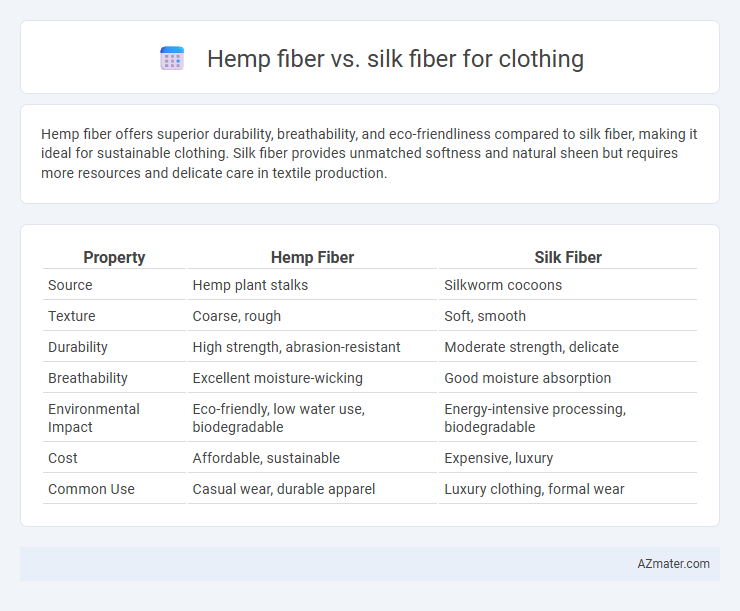Hemp fiber offers superior durability, breathability, and eco-friendliness compared to silk fiber, making it ideal for sustainable clothing. Silk fiber provides unmatched softness and natural sheen but requires more resources and delicate care in textile production.
Table of Comparison
| Property | Hemp Fiber | Silk Fiber |
|---|---|---|
| Source | Hemp plant stalks | Silkworm cocoons |
| Texture | Coarse, rough | Soft, smooth |
| Durability | High strength, abrasion-resistant | Moderate strength, delicate |
| Breathability | Excellent moisture-wicking | Good moisture absorption |
| Environmental Impact | Eco-friendly, low water use, biodegradable | Energy-intensive processing, biodegradable |
| Cost | Affordable, sustainable | Expensive, luxury |
| Common Use | Casual wear, durable apparel | Luxury clothing, formal wear |
Overview of Hemp and Silk Fibers
Hemp fiber is a durable, eco-friendly natural textile derived from the Cannabis sativa plant, valued for its strength, breathability, and moisture-wicking properties, making it ideal for sustainable clothing. Silk fiber, produced by silkworms, is renowned for its softness, luster, and thermal regulation, offering luxurious comfort and elegance in garments. Both fibers serve distinct purposes in fashion, with hemp emphasizing sustainability and resilience, while silk highlights luxury and smooth texture.
Origin and Production Methods
Hemp fiber originates from the stalks of the Cannabis sativa plant, cultivated primarily through a process of retting, breaking, and scutching to separate the fibers, which are then spun into yarn. Silk fiber is produced by silkworms during the cocoon stage, harvested via sericulture that involves carefully rearing the larvae and extracting fibers through boiling or reeling the cocoons. The mechanical and biological production methods of hemp and silk fibers result in distinctive textures and sustainability profiles crucial for clothing applications.
Physical Properties Compared
Hemp fiber exhibits exceptional tensile strength, durability, and moisture-wicking properties, making it highly resistant to wear and suitable for long-lasting clothing. Silk fiber, known for its smooth texture, natural sheen, and excellent elasticity, offers superior softness and drapes well but is less resistant to abrasion and moisture compared to hemp. The higher breathability and UV protection of hemp contrast with silk's superior thermal insulation and lightweight feel, influencing their respective applications in apparel.
Comfort and Wearability
Hemp fiber offers exceptional breathability and moisture-wicking properties, making it highly comfortable for clothing in warm weather, while its natural strength provides durability. Silk fiber excels in softness and smoothness against the skin, offering a luxurious feel and excellent thermal regulation suitable for both cool and warm climates. Hemp fibers tend to be coarser but improve with washing, whereas silk maintains consistent comfort and wearability due to its fine, lightweight structure.
Environmental Impact and Sustainability
Hemp fiber's cultivation requires significantly less water and pesticides compared to silk production, making it a more sustainable choice for environmentally conscious clothing. Silk involves the labor-intensive process of harvesting from silkworms, which raises ethical concerns and consumes substantial resources, whereas hemp grows quickly and regenerates soil health. The biodegradability and carbon sequestration properties of hemp fiber contribute to a lower environmental footprint than silk, supporting long-term eco-friendly fashion practices.
Durability and Longevity
Hemp fiber is renowned for its exceptional durability and resistance to wear, making it ideal for long-lasting clothing that withstands frequent use and washing. Silk fiber, while luxurious and smooth, is more delicate and prone to damage from friction and sunlight, reducing its longevity in everyday wear. Choosing hemp fiber for clothing ensures robust fabric performance, whereas silk offers elegance at the expense of durability.
Breathability and Moisture Control
Hemp fiber offers superior breathability compared to silk, making it ideal for hot and humid climates as it allows air to circulate more freely. Hemp also exhibits excellent moisture-wicking properties, absorbing sweat without retaining dampness, which helps keep the wearer dry and comfortable. Silk fiber, while smooth and luxurious, tends to trap moisture closer to the skin, reducing its effectiveness in moisture control and breathability in active or warm conditions.
Skin Sensitivity and Allergen Considerations
Hemp fiber is naturally hypoallergenic and resistant to mold and mildew, making it suitable for sensitive skin and reducing the risk of allergic reactions in clothing. Silk fiber, while smooth and gentle, can trigger allergies in individuals sensitive to proteins found in silk or exposed to processing chemicals. Choosing hemp fiber garments provides a breathable, durable option with lower allergen potential compared to silk, ideal for those with skin sensitivities.
Care and Maintenance Requirements
Hemp fiber requires less frequent washing due to its natural resistance to odors and bacteria, and it benefits from air drying to maintain strength and prevent shrinkage. Silk fiber demands gentle hand washing or dry cleaning with mild detergents to preserve its delicate protein structure, avoiding exposure to direct sunlight which can cause fading and weakening. Both fibers benefit from low-temperature ironing, but silk requires extra caution to prevent damage from excessive heat.
Market Trends and Consumer Preferences
Hemp fiber is rapidly gaining popularity in the sustainable fashion market due to its eco-friendly properties and durability, appealing to environmentally conscious consumers seeking natural alternatives to synthetic fabrics. Silk fiber remains a luxury choice favored for its sheen, softness, and breathability, maintaining strong demand in high-end clothing despite higher costs and animal welfare concerns. Market trends indicate a growing shift towards hemp as consumers prioritize transparency and sustainability, while silk continues to thrive in niche segments driven by premium quality and traditional craftsmanship.

Infographic: Hemp fiber vs Silk fiber for Clothing
 azmater.com
azmater.com